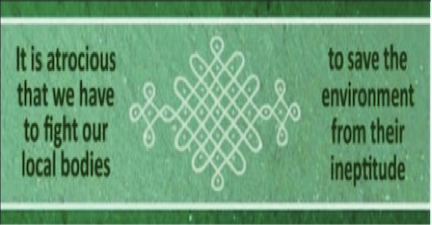Development at cost of biodiversity is a wreck, a warning mark of the environmental disregard of uncontrolled growth. And thus, biodiversity disaster is triggering a public health emergency born from the anthropogenic ecological collapse.
The state retreats from ecological responsibility, with the government discharging its duty to protect environment by surrendering to the corporate control, to the power of private over commons. On this ground, successive governments handed over country’s common wealth (grasslands, riverbeds, beaches, mangroves, seawaters, forests, etc.) to profit-driven companies, turning down commons to tradeable commodities. And so, farming and fisher communities, for example, are being displaced and dispossessed of their natural resources in the name of development.
When governments consider prosperity as a chatter pass for “development”, a marketing catchword exempted of assessment, private players easily grab the regulatory system doomed to protect common resources.
The Government sanction and promotion of private interests destroys wildlife, violates environmental ethics, raises serious questions about governance, accountability, and the cost of development at the expenses of environment. But this blatant disparity is just a sign of a higher disorder paving the way for development.
The attempt to bridge the seemingly contrasting worlds of trade and nature, can be triggered by an assessment of Development Pathways, chiefly focusing on the balance of human needs with environmental preservation, to understand that human development relies on two critical infrastructures, “ecological” (natural systems that provide vital resources) and “economic” (human-made systems, now evolved into industries), grounding the complex interdependence of a region’s ecological health and its economic development.
Though societies can’t expand industries indefinitely without impacting the natural world, unsustainable development pathways are becoming the norm today, and we have become so engrossed in the corporate ecosystem that we’ve forgotten to watch the deforestation, pollution, or resource exhaustion, severely threatening the world ecological infrastructure, forgetting that if resources are used faster than they can be replenished, damaging ecosystems beyond their ability to recover, we are jeopardizing all beings healthy survival.
A new global route challenges this course and claims that conservation can only succeed when local communities are treated as partners, and Indigenous knowledge, practice and experience drives the environmental approach, acknowledging that they have safeguarded ecosystems for generations, and that they must be listened more closely and be part of the decision-making.
A mindful experience of the nature to unlock deeper insights and drive a profound interconnectedness of life, is crucial to raise genuinely sustainable development pathways. Protection awareness must curtail the gap between projects/policies/experts and native communities, guardians of biodiversity, commonly left out of decision-making.
The future of conservation (and restoration) lies not just in science and its garnering practices, but much beyond it, in listening, blending modern research with deep-rooted Indigenous environmental knowledge – as it has been recognized in 2022 by the Kunming-Montreal Global Biodiversity Framework (GBF), the landmark international agreement adopted in 2022 by the Parties to the Convention on Biological Diversity (CBD), underscoring the importance of integrating Indigenous knowledge into conservation and calling to rethink the entrenched power dynamics
Despite this mounting awareness prioritizing community-led engagement and conservation, significant barriers remain, hold by scientists deprived of knowledge in social sciences principles.
